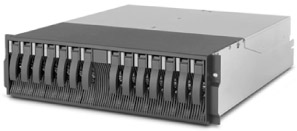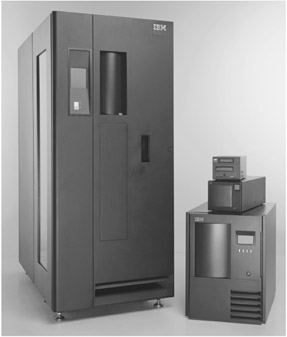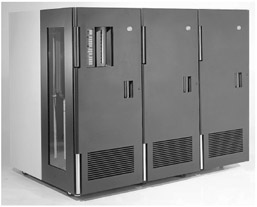Chapter 3: Storage and Printer Building Blocks
|
So far we have surveyed the IBM servers and software components of an on demand operating environment. In this chapter, we will explore the all-important storage component of an on demand computing infrastructure. We will also take a quick look at IBM printers that can be deployed to meet the printing needs of an on demand business.
Storage
Storage devices hold the information that is the life blood of any business, and this is especially true in an on demand business. This information must be made readily available to users and application programs on various servers running various operating systems. This is necessary to ensure application availability, and to support the integration of core business processes, and to gain competitive advantage. So the same integrated, open, virtualized, and autonomic characteristics that are central to server selection are equally important when you select the storage devices and software you will use in your on demand operating environment.
The Storage Management Challenge
In the past, storage devices by themselves were considered to be just another part needed to build a server. Rarely was storage thought of as an independent and strategic tool for business. Today that has changed. As a business moves down the e-business on demand path, the amount of information to be stored grows and the dependency on that information (and thus on the storage devices that contain that information) grows stronger. The accelerating adoption of e-business on demand is therefore driving an ever-increasing demand for more storage with higher levels of availability in order to gain strategic competitive advantage. This in turn increases the costs associated with managing that information and the storage resources that hold it. Left unchecked, the storage management costs quickly dwarf other costs. In fact, IBM estimates that storage management costs can be up to 20 times the initial purchase price of the storage devices themselves. This situation has led to renewed focus on storage management software that helps IT staff deal with issues like such as information availability, backup, security, and the migration of infrequently accessed information to less expensive storage media.
IBM Tivoli Storage Manager is an important tool for addressing these growing storage management needs. It provides core functions such as data backup/restore, managed data archival and retrieval, and protection for business-critical applications. Administration across even large implementations with hundreds of computers and dozens of operating systems is accomplished through a centralized Web-based enterprise console. Additional storage management functions are afforded through complementary products such as IBM Tivoli Storage Manager Extended Edition, IBM Tivoli Storage Manager for Storage Area Networks, Tivoli Storage Manager for Space Management, Tivoli Storage Manager for Data Protection modules, etc.
-
IBM Tivoli Storage Manager
(see page x)
In IBM terms, hardware items—such as disk drives, storage servers, tape libraries, and storage area network switches—and supporting software are part of the IBM TotalStorage family. Here you will find storage products ranging from entry-level devices to enterprise storage systems and storage area networks. TotalStorage products support open standards defined by organizations such as the Storage Networking Industry Association (SNIA). As with servers, storage devices that employ open standards provide for more flexibility when building and evolving an on demand operating environment over time. Virtualization techniques are also used to pool storage for more effective sharing among servers and to enable hardware changes without disrupting users or application programs. Let's take a quick look at the TotalStorage product lines.
Disk Storage
The IBM TotalStorage family offers a variety of disk storage products ranging from direct-attached disk drives to complete enterprise storage systems. In this section, we will look at the TotalStorage product lines in the disk storage arena.
Midrange Disk (FAStT)
The IBM TotalStorage FAStT Storage Server family consists of mid-range rack-mountable storage devices that can be used in multiple operating environments (Microsoft Windows, Netware, Linux, and UNIX). FAStT Storage Servers can be configured for autonomic self-healing data protection using RAID (levels 0, 1, 3, 5, or 10). Attachment to a host computer can be through multiple highspeed Fibre channels to allow the efficient flow of information. You can also attach FAStT Storage Servers to a SAN using a Fibre Channel switch or hub, enabling data transfers at distances of several kilometers. Figure 3.1 shows an example FAStT Storage Server.

Figure 3.1: FAStT Storage Server.
-
FAStT Storage Server info
(see page x)
All of the FAStT Storage Servers can be administered by the IBM FAStT Storage Manager software product. This is a network-based management tool that allows you to centrally configure, monitor, and dynamically change multiple FAStT storage servers.
Enterprise Disk (ESS)
Large-scale IT infrastructures often use the IBM TotalStorage Enterprise Storage Server, or ESS (Figure 3.2). The focus for ESS is on providing advanced performance, automation, integration, and availability functions in support of an on demand operating environment. A single ESS can house up to 384 disk drives, providing as much as 55.9 TB of high-performance, RAID-protected storage. A FlashCopy function creates "point in time" images of data stored on disk to facilitate non-disruptive backup and copy operations for data protection. Because of these capabilities, the ESS is often selected for use in environments where data is mission critical.

Figure 3.2: IBM Enterprise Storage Server (ESS).
The ESS also features a standby capacity on demand function that helps support the variable nature of the on demand business model. For example, when a business orders an ESS with 10 "eight packs" of disk storage, an additional 6 "eight packs" are provided. The business does not pay for this additional storage capacity until it is activated. As with other forms of capacity on demand, this enables operating environments to achieve higher utilization levels without sacrificing the ability to quickly respond to changing needs.
-
Enterprise Storage Server (ESS)
(see page x)
Adherance to open standards (e.g. SMIS) allows ESS to be shared by a mix of simultaneously attached servers including both IBM eServer systems as well as many non-IBM servers. Host interfaces include Ultra-SCSI, Fibre Channel, ESCON, and FICON. ESS is designed for 24 X 7 operation, with no single point of failure. Its fault-tolerant design features include redundant power, cooling, adapters, buses, and processor complexes. Using IBM TotalStorage Expert, a network-enabled integrated storage management tool, systems administrators can analyze, manage, and dynamically reallocate ESS storage (and related tape library resources) among the attached servers as requirements change. This Web-based software allows users to monitor and manage the ESS from anywhere in the world using company-secured network and intranet connections.
Storage Networking
The growing importance of storage has fostered the model for storage infrastructures in which storage devices are not attached to a specific server but rather to a storage area network or SAN.
Storage Area Networks (SANs)
A SAN (Storage Area Network) or SAN is the name given to a specialized high-speed data network dedicated to storage devices. The storage resources residing in a SAN are typically shared among a group of servers attached to the SAN. A Fibre Channel Standard (FCS) type of network is often employed to provide high-speed communications medium (or "fabric") needed for a SAN (though there are some other options including Ethernet and iSCSI). SANs are best suited for situations where performance and scalability are top priorities.
-
Paper: Demystifying Storage Networks
(see page x)
With a SAN, storage resources (disk, tape, etc.) and the information they contain can be efficiently shared, centrally managed, and protected. The benefits of a SAN include higher performance, better utilization (less wasted capacity), scalability, and reduced storage administration costs. SANs are growing in popularity because they allow a business to consolidate, virtualize, and centrally manage heterogenous storage devices.
SANs can be constructed using many different storage building blocks. A mid-range business, for example, might choose to use a FAStT700 as the core of a SAN project. A larger businesses might opt to use the Enterprise Storage Server as the foundation of a SAN implementation. Other SAN building blocks include things like the SAN switches, Fibre Channel Directors, and wiring hubs, which are all parts of a SAN's fabric. Storage management software such as IBM Tivoli Storage Manager can be used to provide additional storage management functions. Sharing of SAN resident disk storage volumes is enhanced by the Tivoli SANergy software product and the SAN Volume Controller.
-
TotalStorage SAN switch
-
Tivoli SANergy
(see page x)
Storage Virtualization Family
The IBM TotalStorage Virtualization family of offerings is designed to simplify, centralize management, decrease downtime, and increase utilization of storage in SAN environments. Here we will cover two offerings in the Storage Virtualization family: IBM TotalStorage SAN Volume Controller and IBM TotalStorage SAN Integration Server.
The SAN Volume Controller consists of a combination of hardware and software that can be integrated into an existing SAN to help simplify, gain control of, and more efficiently share storage resources. Through virtualization techniques, disparate storage devices and their controllers can be pooled into a single view to facilitate sharing among heterogenous servers, non-disruptive management, and higher utilization of storage. The result is improved utilization, reduced complexity, and lower costs associated with a SAN while preserving the existing investment in storage resources.
-
Storage Virtualization family offerings
(see page x)
The SAN Integration Server is another member of the TotalStorage Virtualization family intended for situations when a business needs to implement a new SAN and wants to take advantage of the virtualization capabilities of the SAN Volume Controller. This offering is in fact a turn-key SAN that is pre-configured and installed by IBM. It consists of several products including SAN Volume Controllers, storage, and high-speed Fibre Channel switches. Either of these offerings can be augmented with additional management functions by adding Tivoli products such as Storage Resource Management, Storage Manager, or SAN Manager. Together, these offerings bring virtualization, consolidated systems management, and variability to the storage component of an on demand operaing environment.
Tape Storage
Computing systems are woven deeply into today's business processes and are at the core of day-to-day operations. The information they use is thus a valuable corporate asset that must be protected. Tape storage provides a cost-effective and efficient means of backing up and archiving the information held on disk storage. Tape storage plays a vital role in reducing storage costs, maintaining data availability in the event of hardware failures, restoring data files accidentally or maliciously erased, restoring operations after a disaster, etc. As such, tape storage is a vital part of an on demand operating environment.
IBM offers tape storage devices ranging from entry tape drives to Enterprise Tape Libraries, which can manage up to 6,240 tape cartridges full of information. In this section, we will look at some representative tape storage products.
Midrange Tape (LTO Tape Storage)
-
Animated tour of LTO storage
-
LTO product family
(see page x)
The IBM TotalStorage Ultrium Tape Library is a midrange LTO (Linear Tape—Open) tape storage product line. LTO tape is a superior alternative to DLT, 8-mm, 4-mm, or 1/4 inch tape drives for streaming data applications such as backup. The LTO specification was jointly developed by IBM, Hewlett-Packard, and Seagate. The current products use the enhanced Ultrium 2 data cartridges with capacities of 200 GB or 400 GB compressed, but they can read and write the previous generation Ultrium cartridges. IBM's TotalStorage LTO Ultrium products are supported by the storage management software offered by Tivoli, Legato Systems, and VERITAS Software. They can participate in SAN environments and support an evolution towards an on demand operating environment. IBM reports that they have installed over 130,000 LTO tape products around the world, making them the largest tape storage provider. Figure 3.3 provides a photo of the LTO Ultrium tape family.

Figure 3.3: IBM TotalStorage Ultrium Tape family.
Enterprise Tape (3590 Tape Subsystem)
The IBM TotalStorage Enterprise Tape System 3590 is the most powerful tape subsystem offered by IBM and is intended for use in large enterprise environments. The 3590 has been quite popular, with over 100,000 installed for use with both IBM and non-IBM servers. These tape subsystems are often used for things such as Data Facility Hierarchical Storage Manager (DFSMShsm) work, master file processing, volume dumps, image storage, etc.
-
Enterprise Tape System 3590 details
-
Enterprise Tape Library 3494 details
-
Virtual Tape Server details
(see page x)
There are three components that together make up a 3590 subsystem: one or more tape drives, a tape controller, and a frame. By combining the variations available in each of these components, many different 3590 tape subsystem configurations are possible. This flexibility allows the 3590 subsystem to meet widely varying needs. By using the IBM TotalStorage Enterprise Tape Library 3494 in conjunction with the 3590, you gain the ability to automatically handle up to 6,240 tape cartridges. You can also add the IBM TotalStorage Virtual Tape Library to increase tape processing performance and more fully utilize the storage space on each tape cartridges. Figure 3.4 shows a 3590 subsystem.

Figure 3.4: IBM TotalStorage Enterprise Tape System 3590.
Whirlpool—A Tale of Storage Consolidation
Just as a business can benefit through server consolidation, there are also significant costs savings and performance improvements are achievable through storage consolidation. Here the idea is to take a disparate and often aging set of independent storage devices and consolidate the information they contain on storage devices that can be more easily shared and managed. To illustrate the point, consider what happened at Whirlpool Corporation, headquartered in Benton Harbor, Michigan. Whirlpool, a large manufacturer of home appliances, once had a far-flung computing infrastructure with local data centers scattered around the world—each with its own servers, storage devices, application programs, networking, etc. To reduce costs and improve operations, Whirlpool consolidated the local data centers and put all corporate users on one global network. Some older in-house application programs were retired in favor of key enterprise software suites, including SAP (enterprise resource planning functions) and Siebel (supporting their customer call centers and field service operations). As part of the project, most of Whirlpool's transaction processing was consolidated into one large data center located in Benton Harbor, using four large mainframe servers and over 500 standalone UNIX (including pSeries) and Windows NT servers.
These changes resulted in significant annual savings in networking and data center costs, but Whirlpool had yet to achieve the full benefits from its consolidation efforts. They had not upgraded their aging storage infrastructure, and the response times for their SAP real-time order processing were slowing. The process of backing up the information on their old storage devices to their tape library servers was causing bottlenecks. Their overnight batch-processing window was expanding and was getting closer to interfering with daily "live" operations. In short, the storage component of their infrastructure was not up to the task. Whirlpool solved their storage problems by moving off their slow storage devices. On the mainframe side, they migrated their information from RAMAC Virtual Arrays to three large IBM TotalStorage Enterprise Storage Servers (covered below). As a result, increases in batch processing throughput ranged from 40% to 80%, and Whirlpool had their batch-processing window back under control. The upgrade to ESS also improved response time for the SAP users by 21% in their Whirlpool's European operations and 25% in North America. To support the many UNIX and NT servers, Whirlpool moved away from direct-attached storage devices and implemented storage area networks, giving them the flexibility to allocate and reallocate storage as the server needs change.
-
Whirlpool's e-business projects
(see page x)
According to Jim Haney, Whirlpool's VP of architecture, "Instead of giving everybody only 30% or 40% of the free disk space on a server and wasting the rest, we'll be able to optimize utilization across the storage complex." Over time, Whirlpool intends to support both mainframe and UNIX/NT servers with storage area networks and share the same storage and tape backup devices for both.
|
EAN: 2147483647
Pages: 20